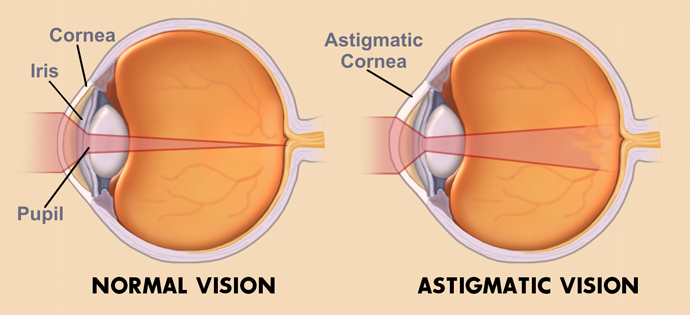Astigmatism is an often misunderstood vision condition. Even saying the name can be a challenge to many people who incorrectly pronounce it as a "stigmatism". Like far and near-sightedness, astigmatism is a refractive error. This means that it is not actually an eye health issue per se, rather an issue with how light is focused upon by the eye.
Eyes experiencing astigmatism fail to allow the retina to rest on a single focal point in order to produce a clear line of vision. Instead, there are numerous points of focus that happen. These focal points can come into play either behind or in front of the retina.

Symptomps of Astigmatism
If you notice your vision to be distorted or blurry at all distances, whether mild or severe, you have the first symptom of astigmatism. Other symptoms of uncorrected astigmatism include headaches, eye strain and squinting.
If you think you have astigmatism it's important that you visit an optometrist to have your eyes tested, you should never self diagnose.
Astigmatism Types
There are three specific kinds of astigmatism.
- Hyperopic Astigmatism- Either one or both the meridians are farsighted.
- Mixed Astigmatism- One principal meridian is farsighted while the other is nearsighted.
- Myopic Astigmatism- Either of the principal meridians are nearsighted.
Astigmatism can also be classified as either regular or irregular.
Regular astigmatism shows the principal meridians separated by 90 degrees. Irregular astigmatism has meridians that are not perpendicular. The most common classification is regular corneal astigmatism. This gives the eye the shape of a football.
An irregular astigmatism can come from an injury to the eye which causes the cornea to scar, various kinds of surgical eye procedures and a disease called keratoconus which causes the cornea to slowly thin out.

Astigmatism Causes
A cornea with an irregular shape is typically what causes astigmatism. Rather than the cornea having a round and symmetrical shape, its shape is more like that of a football. One meridian is significantly curvier than the one that is perpendicular to it.
The flattest and steepest meridians found in an eye containing astigmatism are known as the principal meridians. Astigmatism, in some cases, is caused by the lens shape inside of the eye. This is known as a lenticular astigmatism and is what differentiates it from the more common form of astigmatism - corneal.
Testing for Astigmatism
Astigmatism is usually detected during a regular eye exam with the same techniques and instruments that are used for detecting near and farsightedness. Your optometrist can estimate the amount of astigmatism present by using a test method known as retinoscopy. This method involves introducing different lenses in front of the eye while shining light in at the same time. As the light passes between the lens and the eye astigmatism can be diagnosed.
Although several optometrists still do the retinoscopy, this is a manual procedure that has been supplemented or replaced by instruments that are automated and provide a quicker way to test. But, no matter which test is done, the eye doctor will refine any preliminary findings with a manual test before giving you a lens prescription.
Correcting Astigmatism
Astigmatism can generally be fixed by wearing glasses, contacts or having refractive surgery.
In glasses and contact prescriptions, the axis of astigmatism gives the location of the flattest principal meridian using the 180 degree rotary scale.
In addition to the power of the spherical lens that is used to correct near and farsightedness, an added cylinder type lens power is needed to correct astigmatism.
If you choose to wear soft toric lenses to correct astigmatism, your prescription will include all of the above as well. Contacts that are gas permeable can also correct your astigmatism. Since these lenses optically replace the cornea and are rigid on the refractive surface, the power cylinder may not even be needed at all. This will depend on the severity and kind of correction that is required.
Find a local optometrist near you.
Our local optometrists as well as their facilities are equipped with state-of-the-art ophthalmic technology and years of experience to provide the most effective treatment.
Find an Optometrist